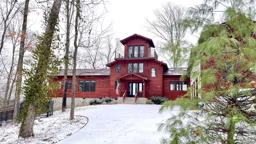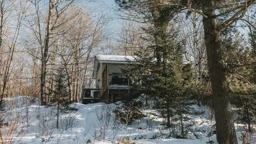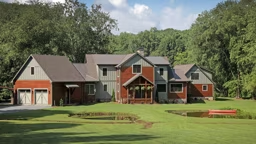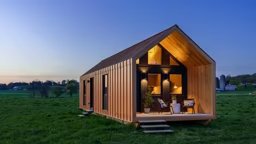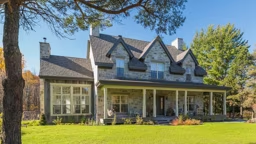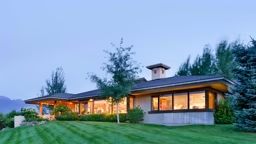If you’ve ever sat in the cool, breezy shade under a grove of pines and watched patterns of sunlight dance above your head, you know just how it feels to be inside this cabin in Truro, Mass., just two hours outside of Boston on Cape Cod.
Truro is one of the most recognizable towns on the Cape, famous for its iconic lighthouse and giant sand dune bluffs overlooking the Atlantic on the east and the flat, sandy beaches on Cape Cod Bay that offer glimpses of Provincetown in the distance.
This property sits on a heavily forested hilltop surrounded by native shrub grasses, with sweeping views of the bay, and it first attracted owners, Harvey Makadon and Ray Powrie, because of its privacy. But an existing mid-century era cabin was dark, dreary and didn’t give them the space they desired for relaxing weekends with frequent guests, so it was demolished to start fresh.
Truro is one of the most recognizable towns on the Cape, famous for its iconic lighthouse and giant sand dune bluffs overlooking the Atlantic on the east and the flat, sandy beaches on Cape Cod Bay that offer glimpses of Provincetown in the distance.
This property sits on a heavily forested hilltop surrounded by native shrub grasses, with sweeping views of the bay, and it first attracted owners, Harvey Makadon and Ray Powrie, because of its privacy. But an existing mid-century era cabin was dark, dreary and didn’t give them the space they desired for relaxing weekends with frequent guests, so it was demolished to start fresh.
When the two found the Truro property, they were in construction on an extensive renovation of their suburban Boston residence with architect Maryann Thompson. “We had exhaustively searched for a cabin that would allow us a quick getaway from our busy careers as physicians,” comments Makadon. “But we found nothing that worked. So while the timing for another building project wasn’t exactly ideal, we just couldn’t pass this spot up.”
Siting the Cabin
Thompson’s design process always starts with finding a way to capture maximum light and move air through a space to create an ideal indoor climate. So before she began conceptualizing this compact weekend retreat, she carefully examined the property and sited the contemporary cabin to make the best use of both. “I have a deep respect for plants,” she acknowledges. “I always try first to get a sense of the qualities of a site and then heighten the conditions that I find in nature.”
Thompson’s design process always starts with finding a way to capture maximum light and move air through a space to create an ideal indoor climate. So before she began conceptualizing this compact weekend retreat, she carefully examined the property and sited the contemporary cabin to make the best use of both. “I have a deep respect for plants,” she acknowledges. “I always try first to get a sense of the qualities of a site and then heighten the conditions that I find in nature.”
Let the Sun Shine In
“Light is always a key motivator,” says Thompson, who operates an award-winning architectural design firm from her residential carriage house in Cambridge and walks to Harvard University, where she’s an adjunct professor in the Department of Architecture’s Graduate School of Design.
“Light is a medium for designers, the way clay is a medium for sculptors,” she compares. “Here, we brought in the light from the tops of the trees through the clerestory windows. But it’s very diffused – not a lot of direct light. Being inside this cabin is like sitting under a giant tree.”
“Light is always a key motivator,” says Thompson, who operates an award-winning architectural design firm from her residential carriage house in Cambridge and walks to Harvard University, where she’s an adjunct professor in the Department of Architecture’s Graduate School of Design.
“Light is a medium for designers, the way clay is a medium for sculptors,” she compares. “Here, we brought in the light from the tops of the trees through the clerestory windows. But it’s very diffused – not a lot of direct light. Being inside this cabin is like sitting under a giant tree.”
Creating a Breeze
Thompson took that light and added the effect of a breeze throughout the cabin by employing a mechanical engineering term called the “stack effect,” which simply means capturing warm air and moving it up and out through operable windows on the upper level. It’s a common-sense sustainable strategy that’s been around for hundreds of years.
“Cross ventilation is extremely important in a pleasant space, because air coming in doesn’t work as long as there isn’t a place for it to go out,” says Thompson. “It’s a technique that was always used in early New England, by adding a cupola to the top of a building, where hot air escaped through the louvers and cool air was pulled in, actually creating a slight wind in the space. It really works!”
Thompson took that light and added the effect of a breeze throughout the cabin by employing a mechanical engineering term called the “stack effect,” which simply means capturing warm air and moving it up and out through operable windows on the upper level. It’s a common-sense sustainable strategy that’s been around for hundreds of years.
“Cross ventilation is extremely important in a pleasant space, because air coming in doesn’t work as long as there isn’t a place for it to go out,” says Thompson. “It’s a technique that was always used in early New England, by adding a cupola to the top of a building, where hot air escaped through the louvers and cool air was pulled in, actually creating a slight wind in the space. It really works!”
Building in Privacy
One of the main requirements that the owners requested from Thompson (and project manager Zac Cardwell) was a means of dividing their vacation home into two distinct parts that would provide their visitors with privacy from the main living space in a small guest quarters. “We really love company … but just not in our house,” Powrie says jokingly.
In response, Thompson and Cardwell developed two separate spaces: kitchen, living and dining rooms, bedrooms and study are in one and a much smaller guest room and bathroom are in another.
To connect the two, they designed an outdoor passageway that doubles as a screened porch, which simultaneously joins and separates the areas, providing ample shade, ventilation and protection from insects in the summer. Exterior walls collapse and slide open, blending the indoors and out in what the owners refer to as “a state of pleasant confusion.”
“Both Harvey and I work too much,” admits Powrie. Since both doctors author textbooks in their specialties, they often take their laptops and write while at Truro.
“But even if I’m sitting at my desk in the study, I feel like I’m on vacation, surrounded by all the trees and light,” he adds. “The 11-foot ceilings in the living room hoist the bedrooms up and bring the forest inside. In the winter, we have so much sunlight streaming in through the big windows, the rooms are often warm enough without any extra heat. In the summer, they’re remarkably breezy and I’ve got a bird’s eye view of the water and sky. It’s really a marvelous place to be, any time of the year.”
Robyn Roehm Cannon writes from Seattle, where she's always attempting to "find the light" behind the continual rain clouds.
One of the main requirements that the owners requested from Thompson (and project manager Zac Cardwell) was a means of dividing their vacation home into two distinct parts that would provide their visitors with privacy from the main living space in a small guest quarters. “We really love company … but just not in our house,” Powrie says jokingly.
In response, Thompson and Cardwell developed two separate spaces: kitchen, living and dining rooms, bedrooms and study are in one and a much smaller guest room and bathroom are in another.
To connect the two, they designed an outdoor passageway that doubles as a screened porch, which simultaneously joins and separates the areas, providing ample shade, ventilation and protection from insects in the summer. Exterior walls collapse and slide open, blending the indoors and out in what the owners refer to as “a state of pleasant confusion.”
“Both Harvey and I work too much,” admits Powrie. Since both doctors author textbooks in their specialties, they often take their laptops and write while at Truro.
“But even if I’m sitting at my desk in the study, I feel like I’m on vacation, surrounded by all the trees and light,” he adds. “The 11-foot ceilings in the living room hoist the bedrooms up and bring the forest inside. In the winter, we have so much sunlight streaming in through the big windows, the rooms are often warm enough without any extra heat. In the summer, they’re remarkably breezy and I’ve got a bird’s eye view of the water and sky. It’s really a marvelous place to be, any time of the year.”
Robyn Roehm Cannon writes from Seattle, where she's always attempting to "find the light" behind the continual rain clouds.









